You hear a click, like the sound of a light switch. Or a pencil being snapped.
You’re facing away from it, looking straight ahead, just as you were instructed. The click and the searing pain you feel are nearly instantaneous. But your mind tricks you into thinking that there’s a distinct period between the click and your first realization that something’s gone very wrong. Maybe that’s because your shooter — friendly and supportive as he may be; congratulatory, even, that you’re dumb enough to volunteer for this — has prepared you for it, warned you that a pain like no other pain is about to strike you in a way you’ve never been struck before.
So you just stand there, waiting for it, on the wrong side of target practice.
When it hits you, no matter how much you expect it, it comes as a surprise — a literal shock, like a baseball bat swung hard and squarely into the small of your back. That sensation — which is actually two sharp steel barbs piercing your skin and shooting electricity into your central nervous system — is followed by the harshest, most violent charlie horse you can imagine coursing through your entire body. With the pain comes the terrifying awareness that you are completely helpless. You cannot move. You lose control of almost everything and the only place you can go is down, face first to the floor.
For five full seconds — an eternity — this continues. Thousands of volts commandeer your body and leave you convulsing, screaming for your life, helpless.
And when it’s over, you want nothing but quiet and calm. You look down at your crotch to make sure you haven’t pissed or shit yourself (you were warned of this possibility) and you’re glad to be clean.
But you don’t want to talk. You don’t want to stand. You don’t want to give a thumbs up or a thumbs down. You just want to be still. You just want to lie there. Motionless. Happy you’re alive. Glad it’s over.
That’s what it feels like to be hit with a Taser.
A company with a market cap of nearly $400 million, Taser International has become a household name. Nearly 90 percent of the 18,000 police departments in the United States use Tasers. The company is about three-quarters the size of gun behemoth Smith & Wesson, mostly on the strength of just one weapon. The company’s founders will tell you the Taser has already "revolutionized policing" by giving officers a non-lethal weapon that’s much more effective than pepper spray, billy clubs, or fists.
And today, the company hopes to revolutionize policing again, with two products that come bundled together: a head-mounted camera called Axon Flex, designed to record audio and video footage from police officers’ point of view, and Evidence.com, a web service designed to store and categorize those videos so they can be used in court to bolster police reports.
Axon Flex and Evidence.com sound like they could be useful for police. But since the technology is so new, and the policies governing it non-existent, one big question goes unanswered: Will such technology help serve and protect the actual people being policed? Or is it destined for abuse, ripe for privacy invasion?

A History of Electric Violence
Jack Cover had always been a tinkering inventor. He studied nuclear physics under Enrico Fermi, and through the 1940s and 1950s he built, among other things, a primitive electric toothbrush, voice activated switches, and devices for testing cooked-food. He’d go on to work for NASA on the Apollo moon landing program, then later IBM and Hughes Aircraft.
But in the late 1960s, following a rash of attempted hijackings, US Marshals were boarding planes with shotguns. Cover knew there must be a better solution. An alternative to firearms on passenger jets. A non-lethal solution. So he kept his ears open. When he heard that a man had been electrocuted but not killed by a downed power line, Cover was struck with inspiration.
Cover submitted the ominous "Weapon for Immobilization and Capture" to the United States Patent and Trademark Office in 1972. A fan of the early 20th century books about Tom Swift’s sci-fi adventures, Cover eventually renamed his invention Taser — an acronym for "Thomas A. Swift’s Electric Rifle."
But it wasn’t until nearly 20 years later that anyone showed interest.
The SEC launched an investigation after more than 40 lawsuits were filed claiming Tasers had severely harmed or killed victims
In 1993, two Scottsdale, Arizona brothers, Rick and Tom Smith, bought the Taser name and patent rights from Cover, who was then in his seventies. They worked with Cover to make the Taser a non-firearm and, by 1998, the Smiths sold their first police Tasers to the Orlando Police Department. By 2001, Taser was a NASDAQ publicly traded company. In three years, Taser’s market cap went from less than $25 million to over $1 billion — a 3,900 percent increase.
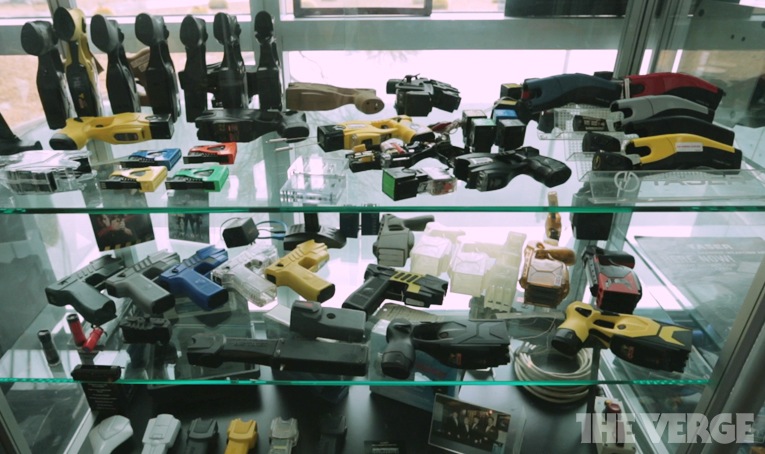
But with this expansion came increased scrutiny over safety. The most severe accusations were aimed at officers using Tasers unnecessarily. So company execs got to thinking: What if police could videotape every Taser’s use? Then they could show their bosses, their accusers — and maybe even juries — exactly what happened before they pulled the trigger. This lead to Taser Cam, a tiny camera attached to higher-end models that began recording as soon as the trigger was pulled.
In 2005 the Securities and Exchange Commission launched an investigation after more than 40 lawsuits were filed claiming Tasers had severely — and unnecessarily — harmed or killed victims. The company’s stock crumbled, dropping 78 percent. When the SEC dropped its investigation in 2006, the stock rebounded to a little less than half its peak. The investigation and subsequent stock plunge showed just how dependant Taser’s fortunes were on a single, controversial product. The company could continue to improve its flagship device, but it also needed to explore new ways to make money.
Since then, Taser has diversified with limited success. Released in 2007, XREP was a wireless stun device fired from a shotgun. It was abandoned. Protector, launched in 2010, was a monthly service that allowed parents to lord over their kids’ cell phone use. It lasted a year. With major competitors — IBM, Microsoft, Nokia, Sony, others — now expanding into the lucrative law enforcement market, Taser knows it needs to innovate once again, to branch out, to diversify.
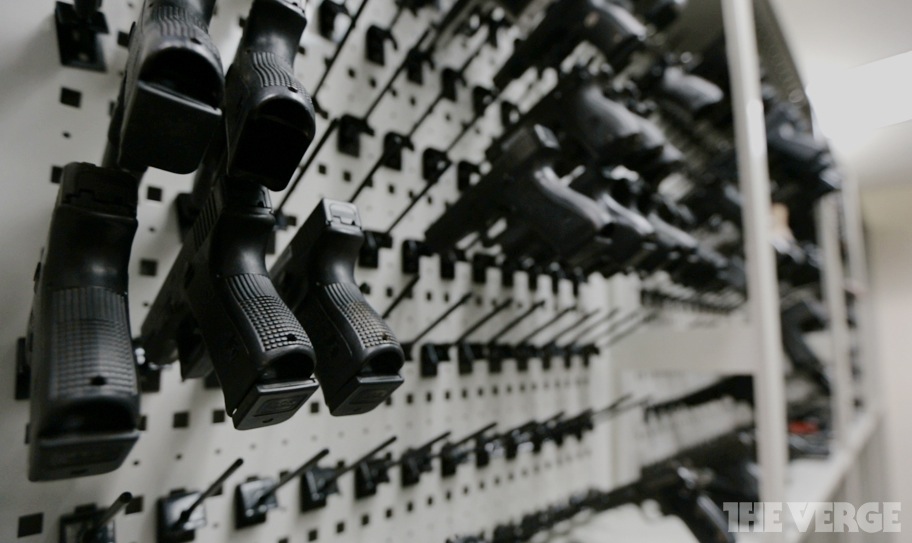
The Showroom
Taser’s diversification is now being tested in the Mesa, Arizona, police department. Mesa’s just a 20 minutes drive southeast from Taser’s Scottsdale headquarters, over the shallow shores of the Salt River and past more rocks and desert than most east coasters see in a lifetime. Thanks in part to proximity, it was no question that Mesa would supply its officers with electric rifles. And now it’s the first police department in the country to purchase Taser’s Axon Flex, the small, always-on camera worn by police officers.
The notion of officer-mounted police cameras perfectly encapsulates the police department’s current policing philosophy, with its strong emphasis on high technology. It’s a philosophy born partly of budgetary necessity. Like many local governments, Mesa has struggled through the Great Recession. In 2011, things got so bad, the New York Times wrote that it was "turning to volunteers" because its police force was so short on cash. Also like many other police departments, Mesa’s has partaken of the more than $4 billion in federal stimulus funding. When the city received more than $1 million in stimulus funding from the American Recovery and Reinvestment Act for "computer systems" improvements, Mesa saw an opportunity.
While it could’ve used that stimulus money on boring administrative stuff — printers or desks or other unsexy office supplies — it instead looked to make Mesa one of the most high-tech departments in the US
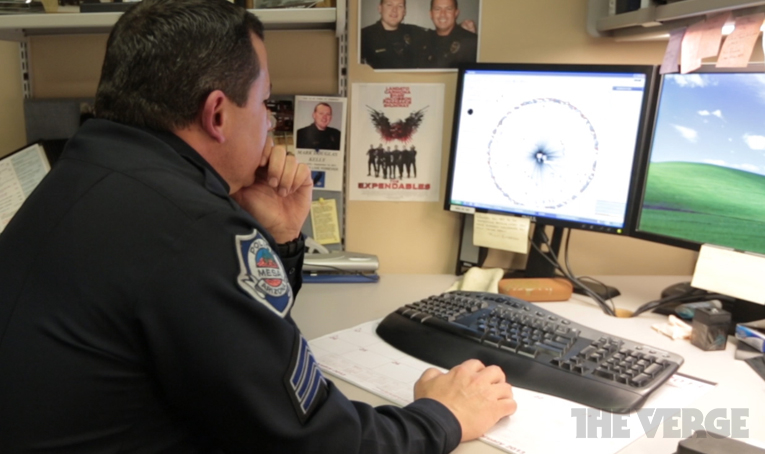
Mesa is now one of only a small number of forces, for example, to use IBM’s Coplink — in tandem with a state fusion center — to connect data on its servers to those of bordering suburbs and the Arizona State Police. Ten years ago, gathering such data would’ve required getting into a cruiser and driving to bordering Chandler or Scottsdale or even Yuma, some three hours away, to pick up files. Today those files are at officers’ fingertips. Mesa is also one of only a few police departments to test mobile fingerprint scanners, which can tap into that fusion center to access any Arizona criminal record from a cop car.
And now Mesa has the Axon Flex. It’s a 3.2- inch-long camera, the size and shape of a small laser pointer, that can be clipped onto a baseball cap or an Oakley glasses frame and wired to a plastic control unit and battery pack a little smaller than a pack of cigarettes. Officers typically clip the control unit two or three buttons down on the inside of the police uniform, just below the chest.
Once switched on, the camera operates constantly, for up to 12 hours. But it only begins recording when the officer presses a quarter-sized button on the front of the control unit. Then it captures the previous 30 seconds of video only, without audio, before beginning full audio-and-video recording.
Protecting your rights would require policies that don't yet exist
Back at the station at the end of a shift (or after an incident), the officer plugs the control unit into a docking base. Called an Evidence Transfer Manager, it’ll charge the control unit and upload video to Evidence.com. That video can then be tagged and labeled by the officer. In addition to a web client, mobile apps are available for iOS and Android.
Administrators are typically high-ranking officers. But regardless of whoever’s doing the editing, files are stamped; according to Steve Tuttle, Taser’s spokesman and vice president, no one is able to edit files without being identified by their login information and the time they worked on the file.
Mesa police department was sold on the system. After a trial run in 2010 and 2011, the city purchased $50,000 worth of the cameras last year.
The investment could have one quick payoff: defending against lawsuits. Though it’s unclear how much the city spends every year defending police officers against brutality claims — or paying out judgements in related lawsuits — it’s something every police officer and department worries about. To give you an idea: last year, allegations from a false arrest and traffic incident forced Mesa to pay $62,500 to settle just one case.
Scott Greenwood is a civil rights lawyer who practices in Cincinnati and Phoenix. He works closely with the American Civil Liberties Union and is, by all indications, one of only a few lawyers in the US working with police to establish concrete rules regarding on-body police cameras. He says police could save millions if Axon Flexes are used properly.
"You really can’t overstate how much liability could be decreased with the use of these devices," he says.

Life on the Surveilled Streets
So, imagine this hypothetical situation: It’s after midnight in a residential neighborhood. Street lights illuminate the pavement. An officer wearing an Axon Flex cruises his beat. His partner is in the passenger’s seat telling "an inappropriate joke about the chief’s wife," in Taser spokesman Steve Tuttle’s example. On the sidewalk to his left, the driver sees a man holding a gun — a stick-up. When the suspect sees the cruiser, he tosses the gun and takes off into the darkness behind a ranch-style house. The driver hits the Axon Flex button strapped under his uniform, parks the car, gets out, and gives chase.
What gets recorded? As Tuttle explains, the Axon Flex has a 30 second video buffer, meaning that your recording will include footage (sans audio) shot a half minute prior to arming the camera. This way, the inappropriate joke is never entered into the record, but the stick-up is preserved for a judge and a jury to see.
That is, if the officer ever catches up with the perp.
Either way, when his shift ends, the Axon Flex unit is returned to the docking station, and any recordings from that night are transferred to Evidence.com. If the video is to be used as evidence, it’s stored indefinitely. If not, it will be stored for 180 days before it’s erased, lost forever.
Greenwood, the civil rights attorney, agrees with Sgt. Landato that the Axon Flex could be beneficial to police while protecting the rights of civilians. But this would require very specific policies. And those policies don't yet exist.
This turns every cop into a surveillance camera
For Greenwood, the main problem with on-body camera systems is that the police officer can choose when and what to record, providing potential for abuse. At the very least, this potentially turns a cop with an Axon Flex into a surveillance camera. Even worse, surveillance is increasingly being used by law enforcement to intimidate people engaging in legal protests and political activity. And if a cop does step over the line — from intimidation to brutality — the camera can just as easily be turned off.
But there’s a simple fix for that, he says. If police departments establish a policy requiring the use of on-body systems only when an officer takes action — only when investigating at a vehicle stop, for example, or responding to a domestic call — then the fear of Big Brother infringing upon free speech gets less worrisome. The camera will only run, in other words, when the protest action rises to the level of arrest (or mass arrest).
He stresses one word: "Recording needs to be a requirement," he says.
Again, it’s a policy intended to curb abuse. If there’s no requirement that every interaction is recorded, then police can make their own decisions about what kinds of stops get the video treatment.
"If an officer is inclined to be discourteous to a person that they're having an interaction with, they could just leave the device off," he says. If that’s the policy, then the cameras are really only benefitting police officers; "it really fails to take advantage of the technology for oversight purposes," he says. And in a perfect world, the cameras would be used by every police officer. That way, Greenwood says, you’d have situations where charges could be dismissed, or juries could be instructed to ignore testimony from an officer that’s not backed up by video.
"Courts are increasingly recognizing the importance of video evidence," he says. "If you’ve got video, and you can establish that the video hasn’t been altered in any way, and you can establish a chain of custody for the video, [a jury] can not believe someone’s word over what’s on the video." What this could lead to, he says, is trials where "it doesn’t matter what the officer testified to. If the video would show, for example, that the subject was acting in a menacing way, then it would be an open and shut case."
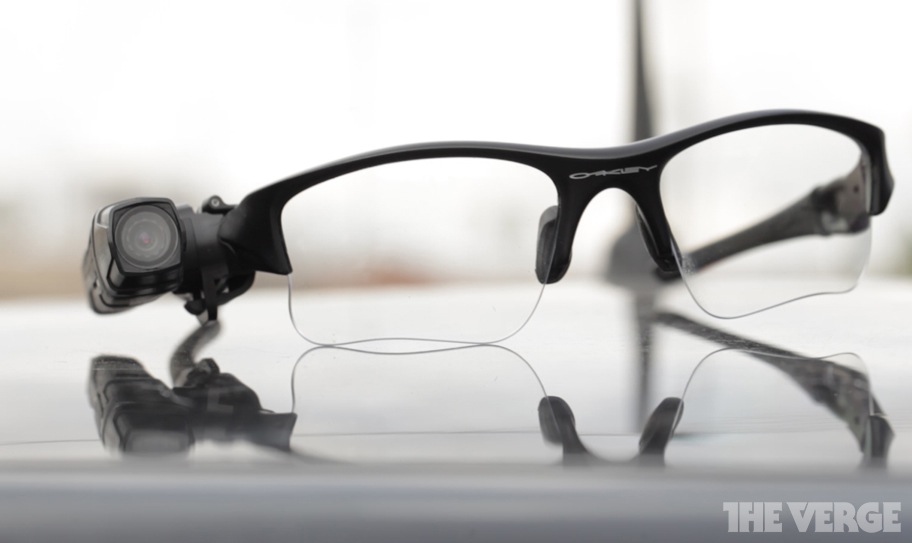
The kingdom that Taser built
Taser’s headquarters sits spectacular and gleaming off the Pima Freeway. It’s incredible, really — a space-agey three-story open layout that you can imagine some Scientologist architect might’ve designed after watching RoboCop 20 times and then 50 episodes of Star Trek: The Next Generation. It’s all shining metal and silver plastic and spotless glass windows facing a huge parking lot and the Arizona desert. Concave doors swoosh open automatically when eyeball-activated security robots recognize certified employees, and 60-foot metal catwalks connect one side of a massive room to the other. It was apparently designed to feel "clubby" and "high-tech," Steve Tuttle explains, grinning.
This is the kingdom that Thomas A. Swift’s Electric Rifle built.
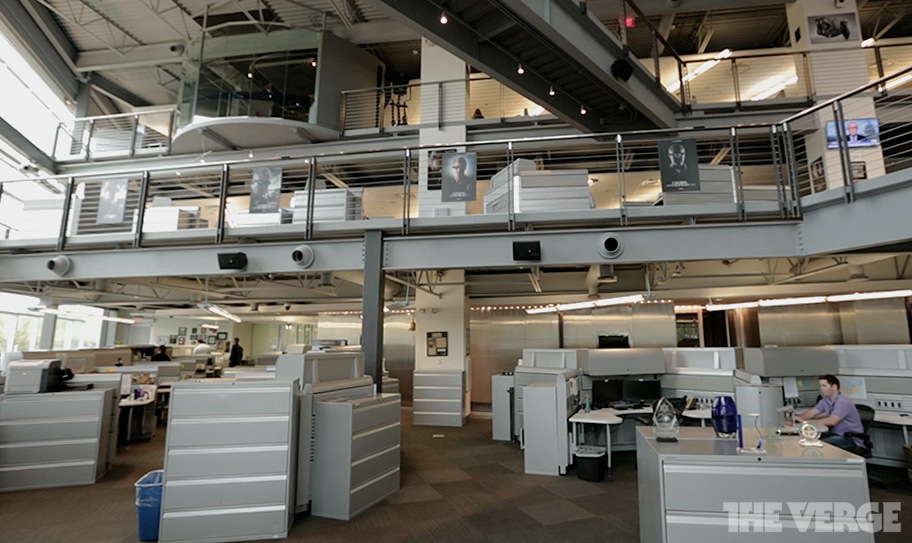
In just about a decade, Taser went from no sales to being a ubiquitous part of US law enforcement. If any company can make on-body police cameras into a profitable business, it’s Taser.
But the Axon Flex, along with the other technologies deployed by the Mesa police department and others throughout the country, are in a kind of public beta-testing phase. These products are ready for municipal use, but questions remain as to their effect: What happens when high-tech policing hits the streets? Can these products be used fairly, or are there implications — social, legal, and ethical — that we can only now begin to understand?
If any company can make on-body police cameras into a profitable business, it’s Taser
These questions matter to the Phoenix branch of the American Civil Liberties Union. And its answer is that new technologies need oversight. Cities and towns — the people being policed — need to define concrete rules. In response to the Axon Flex, the ACLU has assembled an informal group of interested volunteers (lawyers, mostly, including Greenwood) who want to answer these questions and try to create policy around on-body police cameras. They’ve had limited success so far, organizing gatherings of police chiefs and legislators all over the country.
But as the Arizona ACLU’s Executive Director, Alessandra Soler points out, the attempt to create policy is in a very early stage. "There’s just so much up in the air at this point," she says. "There are so many questions."
Video by Stephen Greenwood and Philip Knowlton
Edited by Ryan Manning and Sam Thonis
/cdn.vox-cdn.com/uploads/chorus_image/image/71360778/futurepolice_lede_2.1419979425.0.jpg)